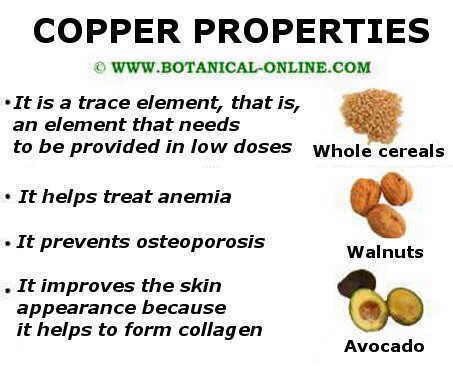Contents [show]
Functions of copper in the human body
What is the function of copper in the human body?
Copper is very important for the body to function well. The main functions of copper can include the following:

Main properties of copper for health
- Provide flexibility to the arteries: Copper is necessary for the formation of certain enzymes involved in the relaxation of arteries and capillaries. This ensures the blood vessels more flexible and the blood circulate better. Lack of copper may lead to a hardening of the same, with the appearance of poor circulation in general or cardiovascular problems such as arteriosclerosis, heart attacks, strokes, etc.
- Good condition of the nerves: Copper is essential for myelin formation. Myelin is a kind of sheath that protects nerves and facilitates the transmission of nerve impulses. Nerve cells well supplied with myelin work better. Their deficiency could be responsible for anomalies such as nervousness, anxiety, stress, etc.
- Good condition of the skin and bones: Copper is involved in the formation of collagen, the protein that forms the basis of skin and bones. Appears in most body tissues (muscles, tendons, hair, eyes, teeth, etc) and is the protein of connective tissue that surrounds and protects the organs. Deficiencies in this component involve the appearance of numerous anomalies, such as difficulty in healing of the skin, wrinkles, blemishes, osteoporosis, arthritis, etc.
- Good skin color: Copper is involved in the formation of melanin, the pigment necessary to provide color to the skin and hair. Problems in the formation of melanin are responsible for conditions such as spots on the skin, hair, vitiligo, etc.
- Good condition of red blood cells: Copper interferes with iron in red blood cell formation. A copper deficiency can cause anemia.
- Good condition of the body’s defenses: Copper protects the immune system so it is necessary to maintain good defenses that protect against infectious diseases
- Preserving fertility: There is evidence that low levels of copper alter the hormones that regulate fertility and decrease libido. On the other hand, the lack of copper may be responsible, as we have seen, for poor circulation that results in a lack of blood to provide nutrients necessary for the sexual organs need to function well. Infertility can be due to the lack of nutrients that causes a low sperm quality in men and poor or irregular ovulation in women.
Copper as an antioxidant
According to recent studies, copper could be seen as a good antioxidant. Its antioxidant effects are due to the ability of copper to produce a natural antioxidants called superoxide dismutase (SOD). (More info)
Therapeutic uses of copper

Copper bracelets are used as a remedy to treat the deficit of this mineral.
A diet rich in copper or copper supplementation may be of interest in the treatment of certain diseases. Among the most important ones, we have the following:
- Hypertension
- Arrhythmias
- Heart disease
- Cholesterol
- Osteoporosis
- Nose bleeding
Copper bracelets to treat some diseases?
According to some theories, the organism absorbs the copper that dissolves with the sweat of the bracelet through the skin. Given the analgesic properties of this metal, copper obtained in this way would help relieve pain in rheumatic diseases such as arthrosis.
Although not scientifically proved, many sufferers have personally expressed that they are relieved when they wear copper bracelets.
Copper daily needs
There is no RDA for copper, though the amounts set out in the table below are considered safe.
Recommended amount of copper in mg (milligrams) | |
From 0 to 5 months | 0,4 – 0,6 |
5 months to 12 months | 0,6 – 0,7 |
From 12 to 36 months | 0,7-1 |
4 to 6 years | 1-1,5 |
7 to 10 years | 1- 2 |
From 11 to 17 years | 1,5 a 2,5 |
18 or older | 1,5 – 3 |
Copper toxicity
Poisoning is very difficult by means of ingesting copper through food. Except in special cases such as Wilson’s disease, the accumulation of copper in the body through food is very rare.
Copper supplements should only be taken when prescribed by a doctor, very high doses may be toxic. A dose of 10 mg at once produce negative reactions characterized by stomach pain, nausea and muscle pain.
Excessive accumulation of copper in the body damages the kidneys and liver and can be fatal
A dose of 30 mg of copper sulfate is lethal to a person. However, the most serious poisonings occur in workers who come into contact with this mineral directly. The daily inhalation of copper fumes damages the lungs.
Permissible values of copper in the work are established at 0.2 mg / m³ for smoke and 1 mg / m³ dust and fog. Copper workers are advised to use goggles, masks and gloves to minimize exposure. It is also recommended by the staff to take a shower and change clothes before returning to their homes.
Copper intake through tap water may be possible in places where this water is polluted by this mineral, which can occur in areas near copper mines. (More information)
Copper from water mainly comes from by dissolution of this mineral from the copper pipes. This can rarely be a health problem. In Europe, water is considered drinkable when it shows up to 2 mg / l dissolved copper in it. In the U.S. the limit is set at 1.3 mg / l. However, with a content of 1 mg / l, tap water actually has an unpleasant taste, although it is considered potable.
One way to avoid ingesting much copper from copper pipes is to let water flow for a few seconds before you drink it or use it for cooking food. This will remove some copper content that is deposited on it.
![]() More information on copper
More information on copper








